
Pink applesauce
Pure applesauce. Life doesn’t get much better.
Home canned applesauce also has another unexpected advantage, besides the taste. You can can it in various sizes jars, so you open just the right size for the need at the time. The ½ cup (125 ml / 4 oz) and 1 cup (¼ litre / ½ US pint / 8 oz) size jars are particularly useful, often containing the exact amount that a recipe is calling for. No more partially-used jars of applesauce lingering in the fridge till they go mouldy!
Feel free to mix apple varieties for a wonderfully complex taste. You can if you wish add some sugar or other sweetener for taste.
Canning applesauce is one of those rare procedures where you have the choice of either water bathing, steam canning, or pressure canning. The pressure canning would not necessarily be safer: it’s likely just an equivalent to the water bathing.
You might also be interested in the Apple Ketchup recipe, which is sort of like a spiced, sweet and sour tangy applesauce.
The end colour of your applesauce will depend on the mixture of apples you used.
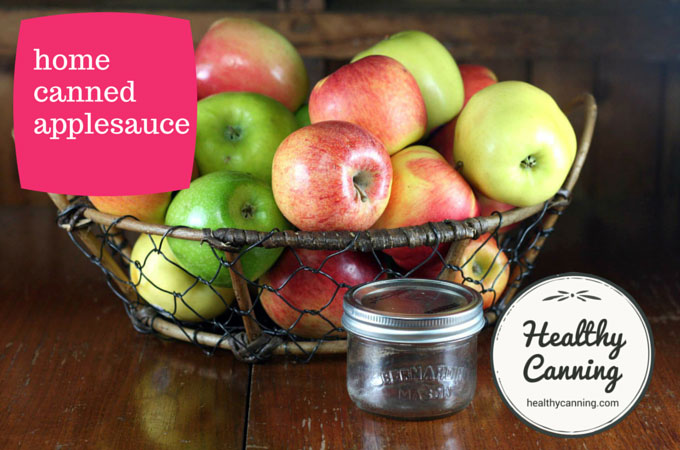
Mixed apples for blended flavour.
Quantities of apples needed
Numbers are approximate guidelines.
On average, as a very rough guideline, expect to need about 1 ¼ kg (3 lbs) of apples per 1 litre (US quart) jar of canned applesauce.
- 9 ½ kg (21 lbs.) of apples = 7 litres (US quarts) canned applesauce
- 6 kg (13 ½ lbs.) of apples = 9 x ½ litres (US pints) canned applesauce
- 1 US bushel apples = 22 kg (48 lbs.) = 14 to 19 litres (US quarts) canned applesauce
The recipe
Jar size choices: Half-litre (1 US pint) OR 1 litre (1 US quart) OR smaller
Processing method: Water bath OR steam canning OR pressure canning
Yield: varies
Headspace: 2 cm (½ inch)
Processing pressure: Only applies if pressure canning. 5 lbs. (35 kPa) weighted gauge, 6 lbs. (42 kpa) dial gauge (adjust pressure for your altitude when over 300 metres / 1000 feet)
Processing time: Varies by method and jar size, see recipe.
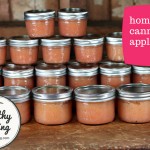
Canning apple sauce
Ingredients
- apples
- water
- lemon juice (bottled. Optional)
Instructions
- Prepare a very large pot or bowl with acidulated water in it (by adding lemon juice or ascorbic acid.)
- Wash, peel, core, seed and slice the apples.
- As you work, work in such a way that peeled apple never rests outside the water, to prevent discolouration.
- Put drained apple slices in a large pot.
- For every 1.25 kg (3 lbs / 20 to 30 medium apples / 12 cups prepped) in the pot, add about 125 ml (½ cup) water.
- Bring to a boil, stirring occasionally, and then reduce to a good simmer for 5 minute to 20 to 30 minutes until all the apple is tender (how long will depend on the apple variety) and starting to break down.
- Press through a food mill or sieve or put through a blender or food processor, OR skip this step if you want a chunky sauce.
- Put sauce back in pot. If desired, sweeten it with up to 2 tablespoons sugar per litre / quart of sauce you estimate you have.
- Bring back to a boil.
- Pack hot applesauce into half-litre (US pint) jars or 1 litre (US quart) jars (OR SMALLER.)
- If desired, add ½ tablespoon bottled lemon juice per half-litre/ US pint, one tablespoon to the litre / quart jars.
- Leave 2 cm (½ inch) headspace.
- Debubble, adjust headspace.
- Wipe jar rims.
- Put lids on.
- Process in a water bath or steam canner or pressure canner.
- Water bath / steam canner: half-litre (US pint) size jars for 15 minutes and litres / quarts for 20 minutes; increase time as needed for your altitude.
- Pressure canner: half-litre (US pint) size jars for 8 minutes and litres / quarts for 10 minutes at 5 lbs (35 kPa) weighted gauge, 6 lbs (42 kpa) dial gauge (adjust pressure for your altitude when over 300 metres / 1000 feet)
- (Note: if you do use smaller size jars, use processing directions for half-litre (pint) jars.
Nutrition
Waterbath / Steam canning processing times
| Required processing time in minutes per altitude | ||||
|---|---|---|---|---|
| Jar Size | 0 - 300 m / 0 - 1,000 ft | 301 - 900 m / 1,001 - 3,000 ft | 901 - 1,800 m / 3,001 - 6,000 ft | Above 1,800 m / 6,000 ft |
| ½ litre (US pint) | 15 min | 20 min | 20 min | 25 min |
| 1 litre (US quart) | 20 min | 25 min | 30 min | 35 min |
Pressure canning processing times
Processing guidelines below are for weighted-gauge pressure canners. See also if applicable: Dial-gauge pressures. When pressure canning, be careful to come up to pressure slowly and let pressure reduce naturally at the end: applesauce can be prone to siphoning out of jars under sudden pressure changes.
| Jar Size | Time | 0 to 300 m (0 - 1000 feet) pressure | Above 300 m (1000 ft) pressure | |
|---|---|---|---|---|
| ½ litre (1 US pint) | 8 mins | 5 lbs | 10 lbs | |
| 1 litre (1 US quart) | 10 mins | 5 lbs | 10 lbs |
Reference information
How to water bath process.
How to steam can.
When water-bath canning or steam canning, you must adjust the processing time for your altitude.
How to pressure can.
When pressure canning, you must adjust the pressure for your altitude.
More information about Sugar and Salt-Free Canning in general.
What is the shelf life of home canned goods?
Recipe notes
- If you go the pressure canning route, don’t let the pressure go over, or your jars will really vent on you and you may have widespread seal failure.
- If you wish to add some ground spices such as cinnamon, cloves, nutmeg, etc, the Ball Blue Book (37th edition, page 18) advises that you do so in the final 5 minutes of cooking. Try ¼ teaspoon at a time, and taste after each addition. But don’t forget: it’s also advantageous to have a few jars of plain applesauce for recipes, etc.
- For a chunky apple sauce, don’t purée it. Or for a semi-chunky, purée only half it.
- The ½ cup (125 ml / 4 oz) jars are very handy sizes of applesauce to have on hand. They’re often just the right amount to go with a meal of pork, etc., for a few people, or, just the right amount for what a recipe is calling for. And they are great for single friends or family members living on their own. However, be prepared to experience a few more failures to seal with that size, as the heat is a lot for its size and the sauce can boil over the rim and prevent a seal, necessitating reprocessing if you get many failures. These jars must be processed for the next tested time up, which is that for half-litres / pints at 15 minutes. For the ½ cup (125 ml / 4 oz) jars, increase the headspace a tidge so that the sauce doesn’t boil up and over the rim, preventing seals.
- If you sweeten the applesauce, bear in mind that hot applesauce tastes tarter than cold sauce, so don’t have a heavy hand with your sweetener or you may regret it the rest of the year every time you open a jar.
- You can reduce the sugar, or use the same volume amount of granulated Splenda®, or use ¼ teaspoon of liquid stevia per litre / quart. For stevia, we’d recommend Better Stevia liquid stevia.
- It is very common for applesauce to develop bubbles in the jar after processing, no matter how well you debubbled the jars. Don’t panic, it isn’t you: it can depend on the variety of apple used, and it won’t affect taste or quality.
Add lemon juice or not to home-canned apple sauce
The most recent edition (2015) of the USDA Complete Guide does not require lemon juice in applesauce. [1] United States Department of Agriculture (USDA). Complete guide to home canning. Agriculture information bulletin No. 539. 2015. Page 2-7.
The Ball / Bernardin Complete Book (2015) does, and explains that it’s for reasons of safety. They want a tablespoon per litre / quart jar:
Adding sugar to applesauce is optional…. However, lemon juice is not an optional addition. Lemon juice is added to help preserve the apples’ natural colour and to assure the acidity of the finished product, since different varieties and harvesting conditions can produce apples of lower acidity.” [2] Kingry, Judi and Lauren Devine. Bernardin Complete Book of Home Preserving. Toronto, Canada: Robert Rose Inc. 2015. Page 182. (Note, though, that they don’t call for lemon juice when canning apple slices on their own. [3]Bernardin Guide to Home Preserving. Toronto, Canada: Bernardin Ltd. 2013, page 38. )
The Ball Blue Book appears to be in transition. It did not call for lemon juice in the 36th edition (2013). By the 37th edition (2014, page 18), though, 3 tablespoons of bottled lemon juice had appeared in the ingredient list for making 3 litre / quarts of apple sauce. But, what to actually do with the lemon juice didn’t actually appear in the directions, reflecting perhaps backroom uncertainty or indecision at the time of publication. Still, the ratio someone was aiming for would appear to be 1 tablespoon per litre / quart jar as well.
Owing to the varying opinions amongst even the reputable sources on this, lemon juice appears to be an optional ingredient. Note that bottled would be required rather than fresh: if you are aiming for extra safety, you would want the guaranteed acidity levels of bottled lemon juice.
Botulism from home-canned applesauce
1931 2 cases, 1 death (Oregon)
1975 1 case, 0 deaths (New Jersey)
How much water?
- The Ball / Bernardin Complete Book (2015) says, “combine apples with just enough water to prevent sticking.” [4]Kingry, Judi and Lauren Devine. Ball / Bernardin Complete Book of Home Preserving. Toronto: Robert Rose. 2015. Page 182.
- The USDA Complete (2015) says 125 ml (½ cup) of water, but doesn’t say per what quantity of apples; it’s possible they mean per 1 ¼ kg (3 lbs). [5] United States Department of Agriculture (USDA). Complete guide to home canning. Agriculture information bulletin No. 539. 2015. Page 2-7.
- The Ball Blue Book (37 edition) suggested ratio of water works out to be 125 ml (½ cup) per 1 ¼ kg (3 lbs) of apples. [6] Ball Blue Book. Muncie, Indiana: Healthmark LLC / Jarden Home Brands. Edition 37. 2014. Page 18.
Varying processing times for applesauce
Both the Ball Blue Book (2014) and the Ball / Bernardin Complete Book call for both pints and quarts (half-litres and litres) to be processed (water-bath and steam canning) for 20 minutes. In comparison, the USDA Complete Guide and So Easy to Preserve call for 20 minutes for the quarts (litres), but call for only 15 minutes processing for the pints (half-litres).
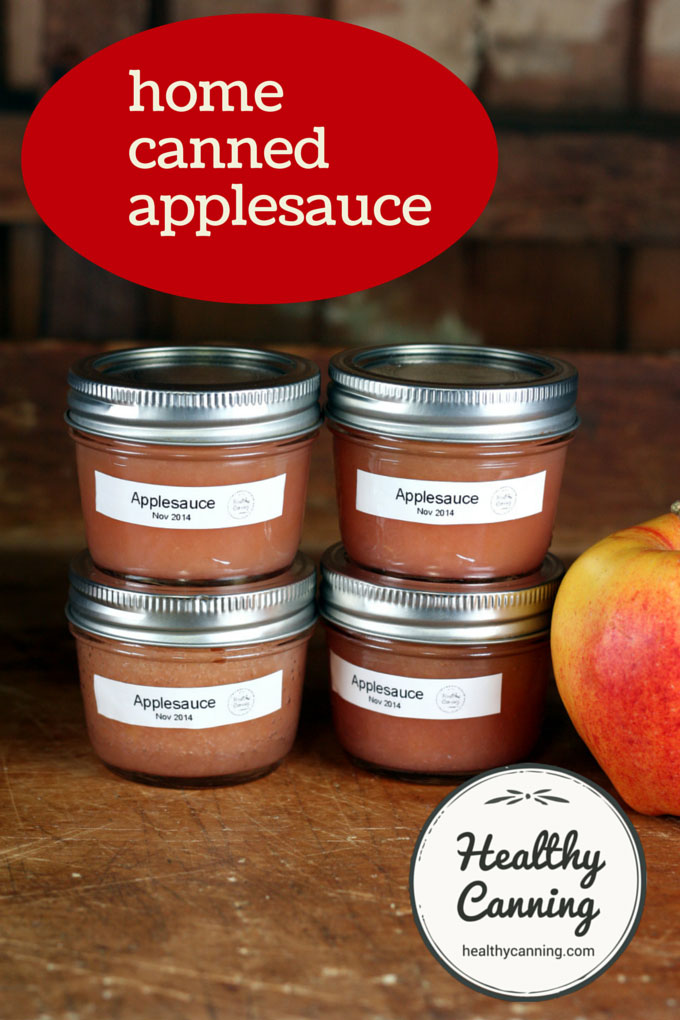
Pink applesauce
Recipe Source
This recipe comes from the USDA Complete Guide (2015).
- Applesauce. In: United States Department of Agriculture (USDA). Complete guide to home canning. Agriculture information bulletin No. 539. 2015. Page 2-7.
Safety Check

With the addition of lemon juice as per the Ball / Bernardin Complete book, this applesauce has a pH of 3.56, measured 1 year after canning. pH will vary of course based on apple variety used, where grown, growing conditions, etc.
Nutrition
Per 250 ml (1 cup / 8 oz) :
- 111 calories, 5 mg sodium
- Weight Watchers PointsPlus®: 0 points (Weight Watchers’ tracker for PointsPlus shows it as free.)
* Nutrition info provided by https://caloriecount.about.com
* PointsPlus™ calculated by healthycanning.com. Not endorsed by Weight Watchers® International, Inc, which is the owner of the PointsPlus® registered trademark.
Applesauce superstition
Ozark tradition held that the success, or otherwise, of your applesauce would be a reflection of your moral character:
Akin to this is the notion that a ‘bad woman can’t make good applesauce’ — it will always be mushy, and not sufficiently tart. This is so generally accepted in some sections as to have passed into the language, and the mere statement that a certain woman’s applesauce is no good is generally understood as a slighting reference to her morals.” [7] Randolph, Vance. Ozark Superstitions. Columbia University Press, 1947. Chapter 4.
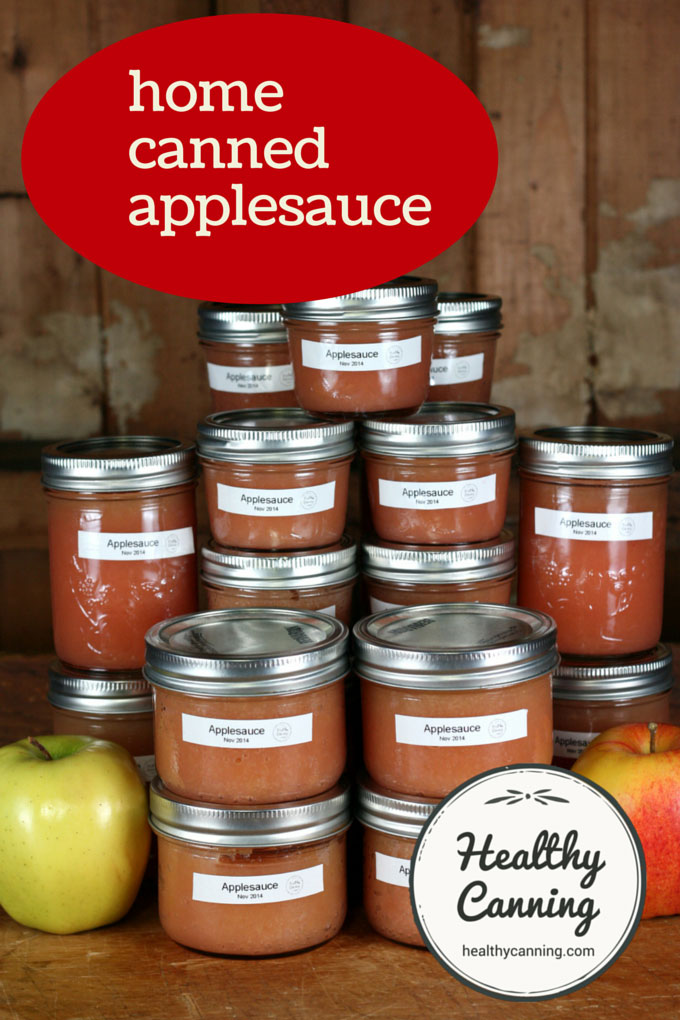
Pink applesauce, in varying sized jars
References

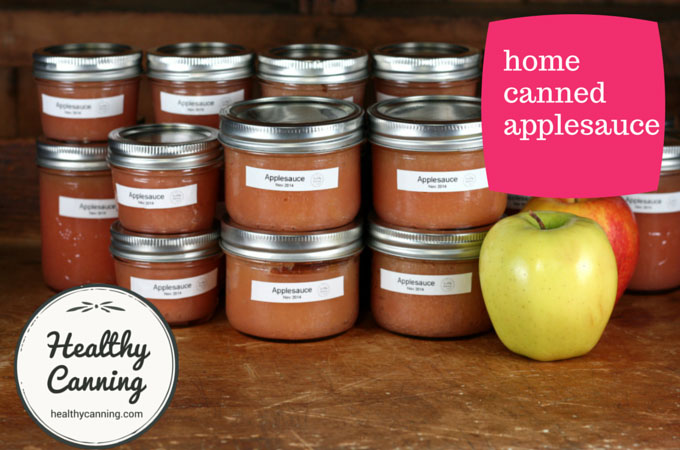
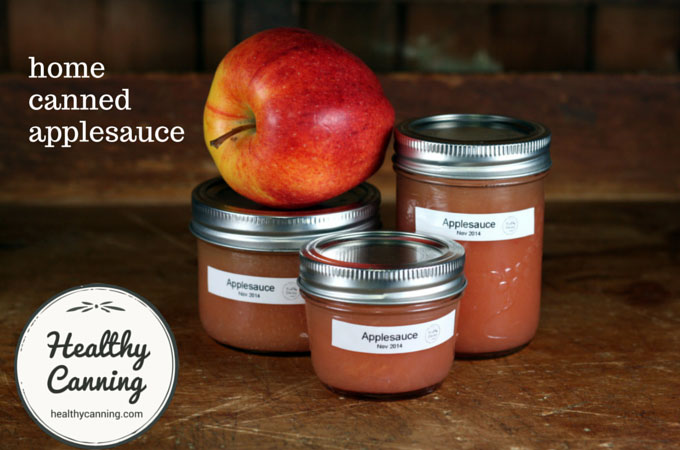
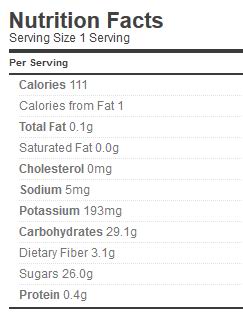
Andre
I like to make apple butter for fresh eating by simply boiling down applesauce until it is thick enough to spread.
It would be nice to have an approved processing time for canning this apple butter. The only apple butter recipe in the USDA 2015 guide involves vinegar, which I find culinarily unappealing. I would have thought that my apple butter method would be more acidic than applesauce since it’s boiled down, meaning it wouldn’t need added acidity to be safe, so I’m perplexed about the reasoning behind the USDA recipe. Couldn’t my apple butter be processed the same way as applesauce? This Ball recipe (https://www.ballmasonjars.com/blog?cid=apple-butter) seems to be doing more or less what I’m talking about. Is that a bad idea for some reason?
Suni Hollenback
Are you leaving the peels on? Is that why the color of yours is rosy pink? I spent about 5 hours making 10 pints of applesauce (Ball recipe said it would make 8 pints) on page 180 of the complete guide to home preserving. It took forever to peel and core (and this was with my kitchenaid attachment. I would love to not have to peel the apples (just cut out the bad spots, quarter and cook. Is this possible?
Carol Ayres
Yes, you can just quarter the apples (cutting out any bad spots) and then after cooking, run them through a food mill to separate out the peels and seeds. Our applesauce gets pinker with each batch as the season goes on and the apples that fall from our tree get redder.
Kelle L Standley
Hello, Would it be safe to substitute unsweetened apple cider for the water in processing the apples for applesauce?
Healthy Canning
Yes
Kellie
Hi
I processed 12 jars of applesauce
And after they cooled on the counter I put them in the refrigerator (I’m not sure why) probably because I didn’t know what to do..my first time)
But I need the refrigerator space …. can I store then in the basement now until i need them or because I refrigerated them that’s where they need to stay what are the “rules”
Thank you !!!
Healthy Canning
If they have been processed correctly using tested directions (USDA, Ball, Bernardin, local Extension service) and the jars have sealed successfully, then yes, they should be stored on the shelf. It’s fine to take them out of the fridge and put them on a shelf. Don’t forget to remove the canning rings (store them away on their own), then wash the jars before storing on shelf.
Lucille Lavender
My applesauce turns dark after a few months on the shelf. They are still sealed and stored in a dark cool room. Any suggestions?
Healthy Canning
Hi Lucille, ask one of these Master Food Preserver groups what they feel.
Maggie
I canned some apple sauce. According to the directions I was supposed to start timing when the water in the canner was boiling. ( it was almost to a boil)I did not do this. The apple sauce was hot when I put it in hot sterilized jars but I timed it (20 mins) from the time I put the jars in the canner and submerged them. All the lids have popped. Also another batch I did, I thought I stirred all the bubbles out but after the canning process I can see bubbles. Is the apple sauce safe?
Healthy Canning
The applesauce was underprocessed. Depending on the variety of apple used, it can be near to impossible to get all the bubbles out.
Katharine glen
Would it possible to sterilise the jars after filling by placing in the oven rather than a water bath?
Healthy Canning
Oven canning is highly unsafe. See here: oven canning
Katharine Glen
Would it work to place the jars after filling in the oven instead of water bath?
Tony F.
I would like to add, concerning the lemon juice, that it does keep the apples from browning, if the juice is drizzled over the apples waiting to be processed.
I made of batch of apple pie filling and after dicing the apples, I drizzled lemon juice over them in the bowl I had placed them in and had something come up during the process. I covered the bowl with plastic wrap and placed it in the fridge. When I had time to finish the process, two days later, the apples looked like they did when placed in the fridge, two days earlier.
Regina Anglin
Why don’t I see recipes for canning applesauce in quart sized jars. How long would I boil it in a electric water bath kettle by Ball.
Healthy Canning
Hi Regina, the 1 quart time is up above. That’s 20 minutes in a boiling water canner, and that applies to the electric one from Ball, too. Good luck! Just remember, apple sauce goes mouldy fast once you open it, even in the fridge, so you may also wish to do a fewer smaller size jars for those times when you need less.
gWhite
Is it necessary to do a hot water bath
Healthy Canning
Your processing choices are Water bath OR steam canning OR pressure canning. If you don’t want to process, then you may freeze it. Use straight-sided jars or containers and leave at least 1 inch headspace for freezing, to allow for expansion.
In terms of health and safety, it’s not acceptable to NOT process the jars if you want to store them at room temperature on shelves: https://www.healthycanning.com/home-preserves-jars-must-processed/
Ruth Nelson
I quarter the apples, unpeeled and uncored – though I do chop out the bad bits (worms, bruises, etc) and then pressure cook them for 15 minutes and run them through the cone-shaped colander with the stand and wooden pestle that we got from my mom. If you’ve never tried one of these, give it a whirl. Nicely low tech and very quick and efficient. You give up the chunky applesauce (which I love) but the method is SERIOUSLY quicker and does’t require stirring. Plus, you waste ZERO apple. All that is left in that cone is thin pure peel and the hard bits and seeds of the core. I know it would be helpful if I could give you measurements but I just fill the pressure cooker about 2/3s full and put in just enough water to get a satisfactory slosh at the bottom.
This is the first year I’ve just gone with the pure apples – so spices, no sweetener. I even left out the lemon juice. The result is tart but tasty and will be useful for cooking.
Oh, and something else I have noticed: Hot applesauce is much more tart tasting than cold or room temp. So bear that in mind when/if you are adding sugar to hot apples. Use less than you think you need and leave it a little on the tart side. Then save out a bit and check it when it’s cool. It will give you a better idea of how much sugar to add.
Cory
What is the shelf life?
Healthy Canning
Hi Cory,
I have heard of (though have yet to research) Amish and Mennonite communities who do their applesauce on a two-year cycle, simply because they happen to favour growing apple trees that are biennial bearers — so they only have the bumper crop of apples to work with every two years.
The flavours of a jar of applesauce in its second year on the shelf may perhaps be a bit more muted than those of its first year — but they will still be cleaner, purer, and better than anything you could buy. Bear in mind though the Amish almost certainly store their home-canned goods in ideal places: cool, dark places. I’ve seen shelving in Amish basements with dark curtains in front of it even to keep out the light.
Here is a full discussion of shelf life for home-canned goods.